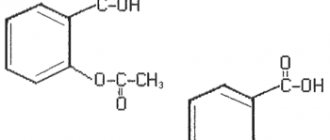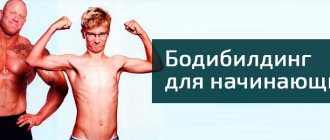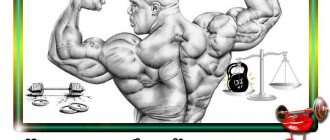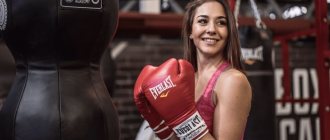The Greatest Strongmen in Mythology
Each of us remembers from school the exploits of strong people in mythology. Gods, titans... Each of them had unimaginable strength (and other abilities). Strength and structure of the male body were cultivated in those days. Currently, sculptures and ancient frescoes testify to this. Remember Atlas? He is one of the Titans, brother of Prometheus. Zeus condemned him for the rebellion and forced him to hold the Earth. Another example is Hercules, the son of Zeus and a mortal. He was distinguished by superhuman strength, bravery and bravery. Everyone remembers his 12 exploits. He managed, among other things, to destroy the Hydra of Lerna and bring Cerberus out of Hades.
The origins of bodybuilding in the USSR
According to party policy, our man needed physical strength and power to work harder and better. But admiring your pumped up muscles in front of the mirror or competing with other jocks for the right to be called the strongest bodybuilder is not the Soviet way, it is a selfish activity hostile to socialist collectivism. This is what they do in the despicable, rotten from head to toe West. Let them continue to rot, and we will go a different way. So the country’s sports leadership raised the question and even issued a special resolution denouncing “exercises aimed at excessively increasing muscle mass.” The decree was issued in 1973, but by that time the pernicious Western plant had already been planted, and a mighty tree grew from it, which could not be cut down even with the active use of the state punitive machine.
Steve Reeves played Hercules in the films: “The Labors of Hercules” (1958) and “The Labors of Hercules: Hercules and the Queen of Lydia” (1959).
A massive passion for Western bodybuilding began with the release of the historical action film “The Labors of Hercules” (1958) with “Mr. America” and “Mr. Universe” Steve Reeves in the title role. By modern standards, the actor did not look super-jocked (biceps girth - 45 cm looks modest next to the 55-60 cm of current champions), but for the 1960s his body was the standard of physical perfection. About forty million people watched the great and mighty movie in the territory. Thanks to this film, people en masse became “jocks,” but strongmen in the Union were respected even before. The exercise system of Evgeniy Sandov, the famous wrestler and circus performer, was known to specialists in pre-revolutionary Russia. This set of exercises laid the foundations of the Russian-Soviet school of bodybuilding. It was still in use in the early 1960s, when Hercules, Reeves and Western bodybuilding appeared in the Scoop.
Interesting articles
- Human zoos: history and photos of zoos with people in Europe and America
- Fashionable clothes of the 80s in the USA (men's and women's)
- Ed and Lorraine Warren - famous paranormal investigators
- 21 best films of the 1960s (Soviet + foreign)
Strong people of the last century - legends of bodybuilding
The current form of bodybuilding dates back to the second half of the 19th century.
Then the legendary bodybuilders appeared. They worked on their bodies on primitive equipment, without training plans drawn up by personal trainers. And they achieved - as it seemed then - the impossible. The German strongman Hermann Goerner (1891-1956) deadlifted 320 kilograms. He lifted this weight with one hand. Another German bodybuilder from the past is Arthur Saxon (1878-1921) “The Iron Master”. He had no problem regularly lifting 130 kilograms above his head with one arm. His record is 167 kg, impressive.
Joe Greenstein (1893-1977) - he was called the “mighty atom.” He was engaged in bodybuilding until he was 80 years old. Interestingly, it was not a problem for him to bend metal with his teeth or break chains. What about the strongmen of the last century? The most recognizable of them is Chuck Ahrens. Its popularity reached its peak in the 1950s and 1960s. Achievements? From simply lifting a dumbbell overhead with a weight of 72 kilograms (4 times), to a chest press of 181 kg (28 times in a row) and squats with a load of 362 kilograms.
Age is not a barrier to training!
Probably everyone knows that testosterone levels in men decrease with age. Thus, anabolic processes deteriorate, and muscles require much more time to recover. With age, the condition of the skin also worsens. The body becomes less flexible and the body more susceptible to injury. This doesn't mean, however, that you have to say goodbye to physical activity.
A living example is the oldest bodybuilders in the world, which we will talk about below. For them, advanced age is not an obstacle to building muscle mass and lifting weights! Bodybuilding for older adults - like any physical activity - is a great way to improve physical fitness. The aging process slows down, the body recovers faster and looks like a 20-year-old. Impossible? See for yourself!
Amateur bodybuilding (as opposed to professional) brings many benefits to human health. The reasons are simple. Firstly, it is useful physical activity (the main thing is not to wear it out), secondly, monitoring your diet, and thirdly, a healthy lifestyle (healthy sleep, no bad habits). All this has a positive effect on a person’s appearance in his old age, postponing, so to speak, aging until later. But what is aging?
In 2013, an interesting joint project between Harvard Medical School, the National Institute on Aging and the University of New South Wales was completed, aimed at studying the characteristics of aging of the human body from the point of view of the behavior of cellular organelles, in particular mitochondria
. Let us remember that mitochondria are the energy stations of cells. Nutrients obtained from food are converted into energy in the mitochondria. The results of the scientific project are presented in the article Declining NAD(+) Induces a Pseudohypoxic State Disrupting Nuclear-Mitochondrial Communication during Aging, published in the journal Cell (Vol. 155, Iss. 7, P. 1624-1638). The main conclusions of the study are as follows:
- With aging, there is a sharp decrease in mitochondrial activity in the cells of the human body.
- The decrease in mitochondrial activity is caused by the loss of their connection with the cell nucleus.
- When the “mitochondrion-nucleus” connection is lost, the normal functioning of mitochondria disappears.
- In the absence of normal functioning of mitochondria, cells lose their regenerative function, that is, they stop renewing themselves and begin to age, reducing their ability to produce energy.
- Aging of cells leads to aging of the body as a whole, to age-related diseases.
The question remains open: is the loss of the mitochondria-nucleus connection a cause or consequence of aging? However, it is already clear that in order to prevent the aging process it is important not to lose this connection. Bodybuilding classes are an excellent stimulator of this connection.
First, the higher your metabolism, the stronger these connections. Weight training increases metabolic processes. After all, heavy strength work is the most active process of energy formation. Depletion of energy reserves during bodybuilding exercises leads to the need to replenish it. Thus, the cell is in a constant process of the arrival of new substances and the departure of old waste ones. Under such conditions, it is almost impossible to lose the connection between mitochondria and the cell nucleus.
Secondly, the metabolic processes in our cells are controlled by hormones. The mitochondria-nucleus connection is controlled by growth hormone. The more growth hormone affects receptors located on the cell surface, the deeper the mitochondria-nucleus connection, and vice versa. With age, the production of growth hormone decreases, which negatively affects this connection. This is precisely why growth hormone is called the hormone of youth - it prevents processes that lead to loss of mitochondrial activity. Bodybuilding training increases the secretion of growth hormone, which means that iron training is an excellent anti-aging procedure. Thyroid hormones are also responsible for metabolic rate. The production of these hormones is usually increased in ectomorphs. Therefore, ectomorphs very often look younger than their age.
Why don't athletes live forever? From the above, you may get the impression that if you go to the gym all your life, you can avoid aging. It's not that simple, friends. The fact is that not only muscle tissue, but also any other tissue consists of cells. Weight training determines the metabolism of muscle cells, but cannot affect the mitochondria-nucleus connection in nerve, fat and connective tissue cells. In addition, there are many muscles in the body that remain untrained with iron (for example, muscles of internal organs). Therefore, bodybuilding is not a cure for immortality. Bodybuilding is the key to long-lasting youth.
2014 © Bodybuilding for hardgainers
Income of Russian bodybuilders
In the USSR, bodybuilding already took place, but it was a semi-legal activity, something like fartsy dumplings. Today, athletes from Russia can easily take part in competitions along with their Western colleagues and even take prizes.
So, TOP 4 most famous bodybuilders in Russia and their income:
Nikolay Yasinovsky
- Nikolai Nikolaevich Yasinovsky (Russian Nightmare)
- 1962, Vorkuta
- Height: 168 cm
- Weight: 97 kg
The exact amount this controversial bodybuilder earns is unknown. There is information that his own business allowed him to earn enough money to move to the United States and bring his family there.
This is the first professional bodybuilder of the USSR, so to speak, a “pioneer” among Russian heroes into the world of big competitions.
Evgeniy Mishin
- Evgeny Aleksandrovich Mishin
- 1976, p. Otradnoe
- Height: 186 cm
- Weight: 140 kg
One of the most famous Russian bodybuilders had to work in a variety of ways on his way to a stellar career. His track record even includes working as a stripper in several nightclubs.
Today he lives and trains in the USA. There he successfully participates in numerous bodybuilding tournaments, trains, and even from time to time tries himself as an actor and model.
Sergey Shelestov
- Sergey Vladimirovich Shelestov
- 1971, Voronezh region.
- Height: 181 cm
- Weight: 122 kg
Repeated winner of the Mr. Olympia, Arnold Classic and other bodybuilding competitions.
Alexander Fedorov
- Alexander Anatolyevich Fedorov
- 1978, Leningrad
- Height: 185 cm
- Weight: 145 kg
The most titled bodybuilder in Russia.
Unfortunately, there is no exact information about how much each specific domestic bodybuilder earns. It is only known that the average earnings of our compatriots in this sport vary in a very wide range: from 30-150 thousand rubles at home to millions of dollars abroad.
The first Soviet bodybuilders
The championship, held in the Moscow hall named after. Pyotr Tchaikovsky in 1948. Circus athletes competed for the title of the owner of the most beautiful physique and the winner was Alexander Shirai, a nationally known aerialist, acrobat and strongman.
Alexander Shirai.
Another key figure for the young muscular movement in the Union is George Tenno, who suffered under the totalitarian regime even before the clash between the bureaucratic system and bodybuilding began. During World War II, a naval officer and amateur weightlifter Tenno served in the navy, and after the end of World War II he continued his military service until he was arrested and thrown into prison in 1948 on charges of espionage. Eight years behind bars, five escape attempts and rehabilitation after the cold summer of ’53. Having received his freedom, the officer immediately returned to his favorite pastime and, in parallel with his work at the research institute, he developed his own innovative training system, summarized in a review work, which in the USSR was called the “Bible for bodybuilders”, “the reference book for Russian jocks” - “Athleticism” , 1968.
Gold medalist Yuri Vlasov at the 1960 Olympics.
Apple-AirPods i12 TWS wireless headphones for iPhone and Android.
US $4.91
US$7.11 -31%
Feminina Women's Seamless High Waist Push Up Leggings.
US $10.39 – 10.70
US $19.98 – 20.58 -48%
Any Men's clothing from the new 2020 collections
US$7.98 – 13.99
24 hour discounts
Bento lunch boxes (900 ml) for storing lunch at work, available in different colors.
US $5.74 – 13.42
US $7.65 – 17.89 -25%
Further, among the main Russian bodybuilders, the names of the famous weightlifters Leonid Zhabotinsky and the gold medalist of the 1960 Rome Olympics Yuri Vlasov should be mentioned. A year later, the Olympic champion performed at the world championship in Vienna, where the Russian giant was seen by a 14-year-old teenager - someone named Arnold Schwarzenegger. The teenager even managed to break through to the athletes and shake hands with the outstanding weightlifter. Soon Arnie will pump up even more powerful arms for himself, although that is a completely different story.
A new meeting years later - Arnold Schwarzenegger with Yuri Vlasov.
Actor-athlete Hercules-Reeves was not the only role model among the jocks. In popularity on the territory of the Union, he was not inferior to the famous Yugoslav gymnast, Gojko Mitic, who went to work in films about Indians. His characters almost always showed off their torsos on screen, and there really was something to look at and be inspired by.
Gojko Mitic as an Indian. Against the backdrop of the popularity of film actors-athletes, specialized gyms for athletic training began to open in the country. In 1962, such a gym appeared in Leningrad. It gained so much popularity among young people that gyms began to open not only in large but also in small cities. Along with the first gyms, regular bodybuilding competitions were born. Like, for example, the Lithuanian Amber Prize tournament, which started in 1968 and is still held today. All-Union championships began to be held in 1971. At the debut tournament in Severodvinsk, local athlete Alexander Lemekhov won, silver – Vladimir Dubinin, bronze – Vladimir Khomulev. A year later, Championship No. 2 took place here, and in 1973 the infamous document was issued that banned professional bodybuilding in the country of socialist competitions and the GTO. For many years, bodybuilding moved to basements, garages and other amateur gyms, where bricks, pipes, rails, car rims, and other devices were used. Bodybuilding continued to exist, although it was actively persecuted from above by government officials who used journalism, public organizations, comradely court and police persecution. The overall result was the stigma attached to Soviet bodybuilders as alcoholics and drug addicts, a disgrace to the nation and a danger to the socialist state.
USSR Bodybuilding Championship in 1971. Persecution and bullying ended with the advent of perestroika, which opened up new opportunities for young people for self-development and improving physical fitness. The training complex of the American guru Joe Weider and other bodybuilding systems became available, and new cool movie musclemen - Schwarzenegger and Stallone - began to appear on videos. “Scoop” has entered an era of tremendous changes. The championships will soon resume, the doors of well-equipped gyms will reopen, where young and gray-haired fans will pull out in orderly rows to lift iron.
The weaker sex: famous female bodybuilders
At first glance, bodybuilding is a purely male activity. However, there was a place in it for the fair half of humanity. It turns out that women can lift weights in the gym just as well as men, building serious muscle mass, and some even earn serious amounts of money from it.
It is difficult to answer the question of who is the richest female bodybuilder in the world, but some of them are breathing neck and neck, combining work on their bodies with running a business, blogging and acting in films and advertising. Among them are the iconic Irene Anderson, Nicole Bass-Fuchs, Iris Kyle, Melissa Coates and others.
Irene Andersen - successful Swedish bodybuilder
The most powerful Nicole Bass-Fuchs from New York
Bodybuilding and fitness star Iris Kyle
Bodybuilding star from Canada - Melissa Coates
Russian bodybuilder Natalya Bystrova
Prev 1of5Next
The absolute leader of the TOP of the richest bodybuilders in the world was and remains Arnold Schwarzenegger. Since bodybuilding is not the most profitable activity, which brings more losses than income to ordinary mortals, the rating has remained virtually unchanged for many years.
In any case, the list of the wealthiest bodybuilders includes people who managed to carve out their own name not only in sports, but also in business, cinema and television. Only with perseverance, willpower and the ability to earn money, you can bring your income from bodybuilding to a high level, and the representatives of our rating succeeded.
Legends and myths of bodybuilding. Part 1
Starting a series of articles devoted to mythical concepts existing in the theory and practice of bodybuilding, let me say a few words about the relevance of this problem. Getting acquainted with numerous publications in popular magazines and on websites devoted to issues of bodybuilding and fitness, seeing the emotional controversy unfolding on numerous Internet forums, you wonder why bodybuilding enthusiasts (both amateurs and professionals) do not look there in search of answers to their questions , where many of the answers already exist - in the textbooks!
Yes, yes, the usual textbooks: on anatomy, general and sports physiology, biomechanics. It is they (and not popular magazine articles, advice from bodybuilding “gurus,” discussions on chat rooms and forums) that should first of all become the foundation on which you can build your conclusions and hypotheses.
Unfortunately, very often this “argumentation” still exists - it’s true because my coach (or a more experienced training buddy) told me so. And his coach told him. What about him? And to him, apparently, his... and so on until the beginning of time... So you can imagine a picture of how a decrepit hundred-year-old coach, dying, whispers in the ear of a student bending over him, telling him to pass it on to his student before his death... I wonder if any of this series of teachers ever doubted this “knowledge” and decided to check it by rummaging through textbooks?
Of course, much in our field remains unexplored (and, by the way, no serious scientific research has been carried out in the field of bodybuilding). Many concepts that bodybuilding enthusiasts have come to, based only on the practice of independent training, confirm their effectiveness and can actually be ahead of scientific data. By the way, Americans call such knowledge, obtained empirically, based only on practical experience, “news from the trenches.” But, nevertheless, there are still so many different myths, erroneous concepts and dense misconceptions that occur due to elementary illiteracy and unwillingness to put a theoretical basis under one’s practical experience.
So, colleagues, let’s do this and try to analyze some seemingly unshakable concepts of strength training.
Myths about exercise
Myth 1 Basic multi-joint movements performed with heavy weights build large, shapeless muscles, and isolated single-joint exercises performed with light weights in an emphatically precise style serve to “polish” the muscles, giving muscles relief and a beautiful shape.
Myth 2 Large weights and a small number of repetitions - for mass, small weights and a large number of repetitions - for relief.
Myth 3 To most effectively stimulate muscle growth, it is necessary to work them through different exercises, “surprising” them and “preventing them from adapting.”
In order to wholesale deal with these myths, which are very rooted in the bodybuilding environment, let's take an excursion into the basics of sports physiology and together try to understand such terms and phenomena as muscle growth, muscle shape and relief, stress and adaptation.
What is muscle growth and what does it depend on?
An increase in the amount of muscle mass as a result of training is one of the manifestations of a process inherent in any living creature and consists in changing the body in accordance with changes in the external environment. This process is called adaptation. All structures of the body and their functions are at the optimal level that ensures the life of this organism in specific conditions. There is nothing “in reserve” (except for such a mysterious organ as the human brain, the capabilities of which many times exceed the needs for it that arise throughout life).
However, if the need for any organ or system increases (or decreases), the body will change in accordance with these needs, increasing or decreasing the capabilities of these organs and systems. An example of such changes is the familiar phenomenon of tanning. By irradiating the body with ultraviolet rays, we expose the body to a load - radiation - and it, in turn, begins to change, saturating the skin with pigment and making it more resistant to this effect.
In the same way, the body can increase its muscles if the need for them has increased. How does this process happen?
The stress experienced by the body during training leads to a variety of negative changes, both in the muscles themselves and in all other systems. The reserves of energy sources - creatine phosphate and glycogen - are significantly reduced in the muscles. Due to a sharp increase in anaerobic glycolysis - the process of energy supply - the chemical composition of muscle fibers changes. The content of adenosine diphosphate, creatine, hydrogen ions, and lactate increases.
The muscle cells seem to be “poisoned”, “acidified”. In addition, microtraumatization of individual muscle fibers can occur, and various protein structures are destroyed. The nervous and neuromuscular system is subject to significant stress. A sharp excitation develops in the central nervous system, which is then replaced by extreme inhibition. Excessive intensity of nerve impulses to the muscles also depletes the nerve cells that generate them. Electrochemical coupling is disrupted during transmission from nerve to muscle.
An additional burden falls on the endocrine system, which is forced to secrete, with special diligence, in increased quantities, first hormones responsible for the urgent supply of reserve energy sources, and then hormones that include restorative, synthetic (construction) processes. The cardiovascular and respiratory systems are not left out.
Now attention! If the load that the body has received is greater than usual, habitual for it, then the central nervous system, having recorded and “processed” information about this, “turns on” the so-called general adaptation mechanism, which is expressed not only in measures aimed at countering a specific type of load, but also general adaptive reactions not related specifically to this load. This state of the body is called by G. Selye a “state of stress” (from English stress - tension), and the situation that caused it is a stressor. I will emphasize - if the load on the entire body has increased, and not just on the specific muscle being worked!
Only in this case will a “hormonal storm” arise in the body, as a result of which it will become possible to urgently supply energy, and then restore spent energy reserves and synthesize those protein structures that were especially needed (including muscles). It is in the composition of urgent adaptive reactions that changes occur that trigger these construction processes carried out during the recovery period. And after the affected body systems are restored to their previous level, the process will continue and, no longer becoming a restoration, but a super-restoration, will bring them to a new level, higher than it was at the beginning.
Now, from the depths of physiology, let’s rise to the surface, to our bodybuilding practice and return to the myths that I promised you to deal with.
So, the first two myths. They talk about form and shapelessness, volume and relief, set and drying. Let's clarify these terms. Let us leave such characteristics of muscles as relief or non-relief, shapeless or worked out to amateurs. The body can be embossed or non-relief, shapeless or elaborate, but certainly not the muscles! The muscles - there, under the skin and fat - are embossed, “dry”, always worked out! Another thing is that they can be big or small, strong or weak.
These are their only characteristics! But the body can really be prominent (that is, with clearly visible muscles) or non-relief. And this will depend not on the muscles, but on the amount of subcutaneous fat located above the muscles. If the layer of subcutaneous fat is thin, then a person will look sculpted even with little muscle mass. Such “athletes” were called “bone carving” or “dried Arnold.”
The only external changes that we can make to muscles are to increase them in size (hypertrophy) or decrease them (atrophy). A muscle cannot change its shape (unless it consists of fibers or bundles located in different directions and carrying out different movements of the bones to which they are attached). It cannot increase with one part of it, cannot become longer or shorter. The only thing we can do with our muscle is to try to enlarge it all, entirely.
All the variety of muscle shapes that can be seen in bodybuilders standing on stage is not due to the fact that they train them differently, but to their genetics. One has a short, peak-shaped bicep, while the other has a flat, long bicep, ending almost at the elbow. One has the widest ones, like the hood of a cobra, going down almost to the pelvis, while the other has them so short that they look like armpit mounds spreading out to the sides of the arms. Everyone does approximately the same exercises, but what shape the muscles will be when they grow (if they grow...) will depend on what the athlete inherited from his parents.
So the only thing we have to worry about is how to make the muscles grow. And, solving this problem, we will really select exercises. But be guided not by what this exercise “polishes” or where some emphasis is shifting, but by what kind of load both the target muscle and the entire body as a whole will receive!
Will the body perceive this load as something new, more powerful in its impact, will the central nervous system “switch on” the mechanism of general adaptation, will a “hormonal storm” rage, will it speed up the activity of the genetic apparatus and the rate of protein synthesis? (By the way, all this does not apply to athletes who use hormonal drugs: a “hormonal storm” is created in their bodies even without triggering this mechanism). This will depend on the number of muscle groups involved in the work during the execution of this movement.
For example, three exercises that target the quadriceps—machine leg extensions, leg presses, and squats—will differ from each other in that the second exercise involves approximately twice as much muscle as the first, and the third involves three times as many muscles. . And not at all because any of them polishes something or “gives the quadriceps a teardrop shape” or does something else.
As a result, we must evaluate not only the exercise itself, but also the person to whom we recommend it. There are no exercises that are absolutely useful or useless, effective or ineffective. For example, a beginner who has no previous experience in engaging in any physical activity, who has a low level of coordination of movements, mobility in joints and the ability to be aware of his body, does not necessarily need to use basic exercises at the beginning, even with light weights.
They are, as a rule, quite technically complex, and the effort to master them will introduce additional discomfort into the initial, (already quite difficult) period of getting involved in regular sports training. For him, the stressor will be the simplest ones, performed on biomechanically designed, injury-proof isolated simulators. Such exercises will be comfortable and simple for him.
And, conversely, for an experienced athlete, only movements that involve the maximum possible number of muscle groups (deadlifts, squats) will be able to have an impact on the body that will exceed the threshold level and include the entire chain of adaptation processes that will ultimately lead to hypertrophy of their muscles. Even if he only needed to increase his biceps.
Hypertrophy can be caused by any training regimen: both volumetric (high-repetition) and high-intensity. Another thing is that different parts of the muscle fiber will increase: myofibrils (contractile elements of the muscle), mitochondria (its micropower plants), sarcoplasm (intracellular fluid with all its contents), and other muscle elements. Some regimes will be more effective for a particular athlete, some less so. One athlete may have a greater tendency to hypertrophy due to sarcoplasm, another - due to myofibrils. But all these modes are designed to solve a single problem - to increase something in muscle tissue!
The same thing applies to working muscles from different angles and using different exercises. I repeat that at different angles you need to work only those muscles that consist of bundles located in different directions and performing different movements. For example, the trapezius muscle with its upper part raises the shoulder blades, the middle part brings them to the spine, and the lower part lowers them. Therefore, to load the upper part, we will need to use shrugs, the middle part is involved in moving the shoulder girdle back when pulling on a horizontal block to the stomach, and the lower part is involved in the work when we lower the shoulder girdle down, performing pull-downs to the chest on a vertical block. In all other cases, when choosing exercises, we should be mainly interested in the number of muscles involved in the work, and not in how the exercise looks.
But in order to make the adaptation process continuous and not fall into a state of slack... excuse me, stagnation, you need to change the nature of the load - the number of repetitions, weight, speed of movement, allow or not allow the muscle to relax between repetitions, use or not use the inertia of the projectile movement , peak isometric contraction and other parameters. It is the nature of the load, and not exercises that are equivalent in the number of muscle groups involved in the work. You can change them, but only so that it’s not boring to swing.
But I’ll tell you where these myths came from and how to still achieve such a coveted relief in the next article.
Author - Dmitry Kalashnikov, Chairman of the Association of Fitness Professionals, ISSA Certified Personal Fitness Trainer.
Greg Kovacs
Another article:
The most famous sailors
Even the biggest bodybuilders pale in comparison to this man, which is not surprising given his weight and height. He is significantly shorter than Noah Steere, but in terms of muscle mass he leaves him far behind. Out of season, its weight can reach 184 kilograms. True, he “loses a little weight” for competitions in order to better emphasize his impressive muscles. Then its mass is “only” 148 kilograms.
But he did not stay in professional sports for long, exchanging it for a calmer and more measured life as the owner of his own gym. This is probably the profession every bodybuilder dreams of – training without leaving your workplace.
Giliano Stroe
Perhaps this kid will turn out to be a famous big bodybuilder, perhaps over time he will lose interest in professional sports, but now he remains the most muscular child. The father, who himself was professionally involved in sports, began taking his son to the gym at the age of two. While dad maintained his muscles, the baby also learned the basics of bodybuilding.
Are you weak?
As a result, at the age of five he entered the Guinness Book of Records when he was able to walk 10 meters on his hands. Afterwards, he repeatedly amazed the public with his sporting achievements. His caring dad regularly posts his photos and videos on the Internet.
Some people admire such parents and their child, but the majority view them very disapprovingly, accusing them of bullying the child and a dangerous experiment on his health. Parents claim that the child will only enjoy such sports activities. When he gets tired, like all children he loves to watch cartoons, draw or play with his peers. But they can be sure that the older boys will never offend him.
The same thing is often said to all other bodybuilders (adjusted for age, of course). Some people admire such muscular men, others consider it unnatural and stupid, but few critics dare to express their opinion to the bodybuilders themselves.
Flex Wheeler
Although he is the only professional bodybuilder on this list who has never won the Mr. Olympia title, this does not diminish his overall career success. Having won the Arnold Classic 4 times and received many more awards, he has proven that he deserves to be included in the list of the best bodybuilders of all time.
In addition, Arnold Schwarzenegger and Ronnie Coleman noted him as one of the greatest bodybuilders. It impresses with its symmetrical aesthetics. More commonly known as the "Sultan of Symmetry". Contrary to popular belief, the nickname "Flex" comes from his remarkable flexibility, and not from the fact that his muscles are good at flexing.











